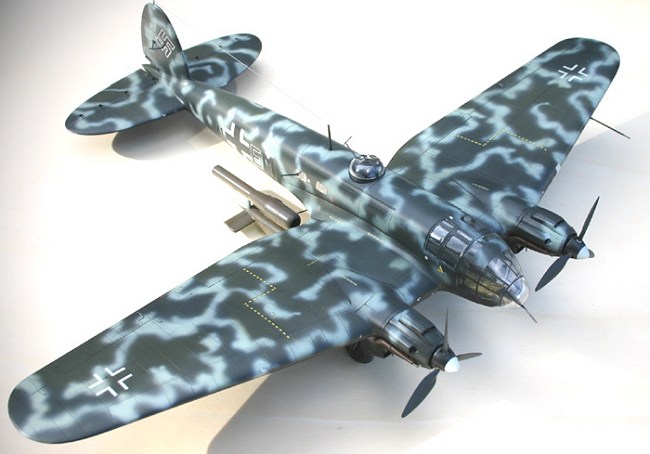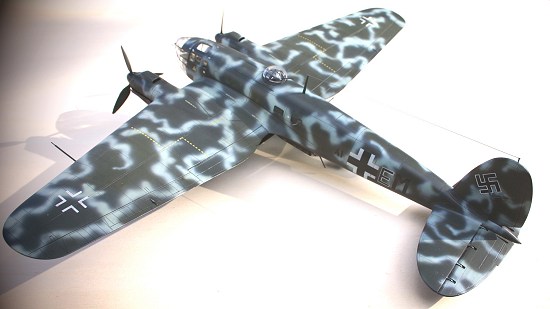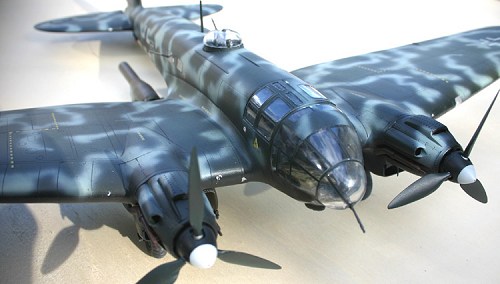
|
KIT # |
? |
|
PRICE: |
45 Swiss Francs |
|
DECALS: |
Two aircraft - II./KG 53 |
|
REVIEWER: |
|
|
NOTES: |
Same as ProModeler kit |

|
HISTORY |
Several examples of the early
bomber versions (Heinkel 111 B, E) were sent to Spain to fight the Civil
War with “Legion Condor”, gathering precious experience for the coming
hostilities planned by the Nazi regime. However, the Heinkel’s then
 superb speed and handling characteristics, as well as a relatively light
opposition hid the type’s shortcomings (lack of protection, too light
defensive armament and bomb payload), giving its crews – and their
leaders - a false sense of invincibility they would pay for dearly
during WWII. From the He-111 P version on, a fully glassed nosed was
fitted, giving the Heinkel its definitive, unmistakeable look and
excellent visibility – but over-exposing the crew to enemy fire. At the
beginning of the Polish campaign, the Heinkel 111 had become the most
numerous bomber in the Luftwaffe, with 808 of all marks equipping 21
groups and several smaller units.
superb speed and handling characteristics, as well as a relatively light
opposition hid the type’s shortcomings (lack of protection, too light
defensive armament and bomb payload), giving its crews – and their
leaders - a false sense of invincibility they would pay for dearly
during WWII. From the He-111 P version on, a fully glassed nosed was
fitted, giving the Heinkel its definitive, unmistakeable look and
excellent visibility – but over-exposing the crew to enemy fire. At the
beginning of the Polish campaign, the Heinkel 111 had become the most
numerous bomber in the Luftwaffe, with 808 of all marks equipping 21
groups and several smaller units.
During the “Blitzkrieg” campaigns of 1939-1940, the He-111 gave complete satisfaction (in spite of severe losses as soon as serious opposition was met). Things were to change quickly during the Battle of Britain, where the type, pressed into a strategic bomber role it hadn’t been designed for, proved unsuitable for the task. However, as Germany had nothing better at hand than tactical bombers like the He-111, Ju-88 and Do-17 (the Nazi “Lightning War” philosophy having lead the RLM into neglecting the development of “heavies” - with the exception of the ill-fated He 177”Greif”), the Heinkel 111 soldiered on during the whole war as a “maid of all works”, performing all kinds of missions on every front like weather observation, reconnaissance, transport, torpedo-bombing, mine-laying, glider-towing, VIP liaison or V-1 flying-bomb delivery, which is the subject of this kit.
7585 Heinkel 111’s of all types were built from 1935 on, production being stopped in 1944, and the last remaining 9 being destroyed by their crew on a Bavarian airfield prior to surrender in 1945.
The Heinkel 111 H-22
The third version of the H series
(recognizable by its dorsal turret replacing the former open defensive
position) was to be one of the most unusual weapons of WWII. Its mission
was the nocturnal delivery of the (in)famous Fieseler Fi 103 flying bomb,
better known as the V1 (Vergeltungswaffe eins – “retribution weapon
one”), the unguided ancestor of the Cruise Missile. Germany having lost
the original (and
 vulnerable,
in spite of their heavy Flak defences) “ski-jump” firing sites on the
Channel coast due to the Normandy invasion, the solution found to
continue the V-1 random bombing campaign against Britain was to fit a
flying bomb under the starboard wing of a He-111 of the latest mark. In
comparison with today’s push-button, high-tech weaponry, the delivery
method was primitive and dangerous, to say the least.
vulnerable,
in spite of their heavy Flak defences) “ski-jump” firing sites on the
Channel coast due to the Normandy invasion, the solution found to
continue the V-1 random bombing campaign against Britain was to fit a
flying bomb under the starboard wing of a He-111 of the latest mark. In
comparison with today’s push-button, high-tech weaponry, the delivery
method was primitive and dangerous, to say the least.
First, the bomber, slowed by its bulky load, had to “crawl” very low over the North Sea to escape radar detection. Once in range (100 – 150 Km), the pilot accelerated to 320 Kmh and climbed to 400m, started the V-1’s pulse-jet engine and released it in the general direction of the “target” (let’s say the British Isles). In this moment, the flying bomb’s exhaust flame often gave away the Heinkel’s position to a patrolling Mosquito night-fighter, which subsequently had no difficulty to track and shoot down the intruder. Some 80 He-111 H-22 of II KG 53 (the unit assigned to this dangerous “game”, flying from Northwest Germany and Holland) were lost that way, several others to night-flying accidents.
|
THE KIT |
The H-22 issued by Revell Germany (one year after the original Monogram / Revell release of the bomber / torpedo version) comes of course in the usual soft, side-opening box that is the main weakness of this company. The kit itself, in return, is one of the best aircraft models available. Nice recessed panel lines, superb cockpit details, clear and well designed transparencies, excellent crew figures, well-printed decals (including useable seatbelts) and a decent V-1… if it wasn’t for the notorious “Revell parts-warping”, it would be of outright AM or Tamiya class. The plans are clear and easy to follow.
|
CONSTRUCTION |
 After assembling and painting all
internal parts, which was done without a problem, putting together the
airframe revealed the only – yet annoying flaw of this nice kit: fitting
the main parts is a tricky job, and a lot of putty was necessary to hide
the seams. Worse, a closer look after the first sanding session revealed
that the tail planes had misaligned while curing, this being maybe due to
some fuselage warping… I had to break them off and insert some plasticard
in the seams to give them the right angle, and to bend the fin into
correct position. However, after a second filling, sanding and
reengraving session, none of this heavy intervention was left to be seen.
After assembling and painting all
internal parts, which was done without a problem, putting together the
airframe revealed the only – yet annoying flaw of this nice kit: fitting
the main parts is a tricky job, and a lot of putty was necessary to hide
the seams. Worse, a closer look after the first sanding session revealed
that the tail planes had misaligned while curing, this being maybe due to
some fuselage warping… I had to break them off and insert some plasticard
in the seams to give them the right angle, and to bend the fin into
correct position. However, after a second filling, sanding and
reengraving session, none of this heavy intervention was left to be seen.
A few months later, I asked a usually quite well-informed modelshop owner about the cause of this typical Revell warping problem, and here’s what he told me : apparently, the guys at Revell turn out kits at high speed and take the sprues out of the forms before they have time to cool down completely – hence the warping. The Japanese, he said, have learned that slowing down production a little bit eliminates the problem... just my 2 cents, as they say on the Forum.
Further details
The landing gears are highly detailed, yet strong enough to take the model’s quite heavy weigth. “Flattened” wheels (including the tailwheel) with accurate tire profiles are provided. The V-1, almost a small kit in the kit, is pretty nice. Experts probably will argue if it’s better than the Tamiya issue, but, according to my documentation, it doesn’t look bad at all – and is largely hidden under the Heinkel’s large elliptical wing. As already said above, the transparencies are of exquisite optical quality, and their clever breakdown eliminates any ugly seam or ejector pin mark. The 5 defensive MGs are well represented. The propellers and exhaust pipes are very good, too.
|
CAMOUFLAGE & MARKINGS |
 The machine I chose to represent
belonged to II KG 53 and flew its missions in late 1944. It sported the
classic 70/71 upper scheme with a heavy “night-fighter like” RLM 02 grey
or 65 blue pattern sprayed over (I chose the 65 option because of the
better contrast). The undersides are black. As for the V-1, I wanted it
to look somewhat different, so it got a 80 olive-green over blue 65 camo.
The “greenhouse” nose was masked and airbrushed over the larger areas
(pilot’s escape hatch, bombardier/nose gunners “tub”). Thin, pre-painted
decal stripes were used for the rest of the framing. An oil wash followed
by pastel powders were applied for weathering. Decals went on fine, with
no silvering in spite of their matt base.
The machine I chose to represent
belonged to II KG 53 and flew its missions in late 1944. It sported the
classic 70/71 upper scheme with a heavy “night-fighter like” RLM 02 grey
or 65 blue pattern sprayed over (I chose the 65 option because of the
better contrast). The undersides are black. As for the V-1, I wanted it
to look somewhat different, so it got a 80 olive-green over blue 65 camo.
The “greenhouse” nose was masked and airbrushed over the larger areas
(pilot’s escape hatch, bombardier/nose gunners “tub”). Thin, pre-painted
decal stripes were used for the rest of the framing. An oil wash followed
by pastel powders were applied for weathering. Decals went on fine, with
no silvering in spite of their matt base.
|
CONCLUSIONS |
This is the second-largest kit I ever turned out, and it has become one of my favorite ones (although it was started without conviction on a day I just wanted to “do something”). Fitting problems apart, the build was great fun, and the result makes a very big impression every time it’s on display (maybe due to its large size and funky camo), my Heinkel making first and second at two exhibitions. Someday, I’ll take it to the Swiss IPMS nationals…
May 2004
|
REFERENCES |
Squadron Signal „Heinkel 111 in Action“
Editions Atlas « Bombardiers moyens de la deuxième Guerre Mondiale »
Monogram « Luftwaffe aircraft colours »
Copyright ModelingMadness.com. All rights reserved. No reproduction in part or in whole without express permission from the editor.
If you would like your product reviewed fairly and fairly quickly, please contact the editor or see other details in the Note to Contributors.